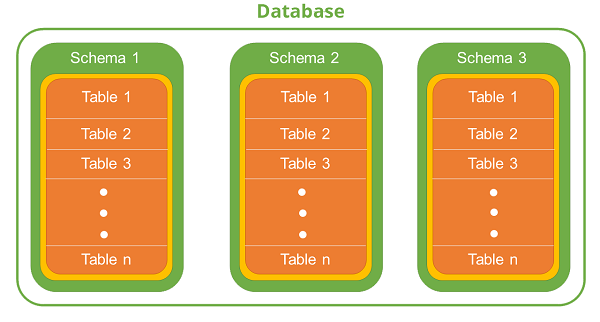
- Home
- DB2 - Introduction
- DB2 - Server Installation
- DB2 - Instance
- DB2 - Databases
- DB2 - Bufferpools
- DB2 - Tablespaces
- DB2 - Storagegroups
- DB2 - Schemas
- DB2 - Data Types
- DB2 - Tables
- DB2 - Alias
- DB2 - Constraints
- DB2 - Indexes
- DB2 - Triggers
- DB2 - Sequences
- DB2 - Views
- DB2 with XML
- DB2 - Backup and Recovery
- DB2 - Database Security
- DB2 - Roles
- DB2 - LDAP
DB2 - Schemas
This chapter introduces and describes the concept of Schema.
Introduction
A schema is a collection of named objects classified logically in the database.
In a database, you cannot create multiple database objects with same name. To do so, the schema provides a group environment. You can create multiple schemas in a database and you can create multiple database objects with same name, with different schema groups.

A schema can contain tables, functions, indices, tablespaces, procedures, triggers etc. For example, you create two different schemas named as Professional and Personal for an employee database. It is possible to make two different tables with the same name Employee. In this environment, one table has professional information and the other has personal information of employee. In spite of having two tables with the same name, they have two different schemas Personal and Professional. Hence, the user can work with both without encountering any problem. This feature is useful when there are constraints on the naming of tables.
Let us see few commands related to Schema:
Getting currently active schema
Syntax:
db2 get schema
Example: [To get current database schema]
db2 get schema
Setting another schema to current environment
Syntax:
db2 set schema=<schema_name>
Example: [To arrange schema1 to current instance environment]
db2 set schema=schema1
Creating a new Schema
Syntax: [To create a new schema with authorized user id]
db2 create schema <schema_name> authroization <inst_user>
Example: [To create schema1 schema authorized with db2inst2]
db2 create schema schema1 authorization db2inst2
Exercise
Let us create two different tables with same name but two different schemas. Here, you create employee table with two different schemas, one for personal and the other for professional information.
Step 1: Create two schemas.
Schema 1: [To create schema named professional]
db2 create schema professional authorization db2inst2
Schema 2: [To create schema named personal]
db2 create schema personal authorization db2inst2
Step 2: Create two tables with the same name for Employee details
Table1: professional.employee
[To create a new table employee in the database using schema name professional]
db2 create table professional.employee(id number, name varchar(20), profession varchar(20), join_date date, salary number);
Table2: personal.employee
[To create a new table employee in the same database, with schema name personal]
db2 create table personal.employee(id number, name varchar(20), d_birth date, phone bigint, address varchar(200));
After executing these steps, you get two tables with same name employee, with two different schemas.
